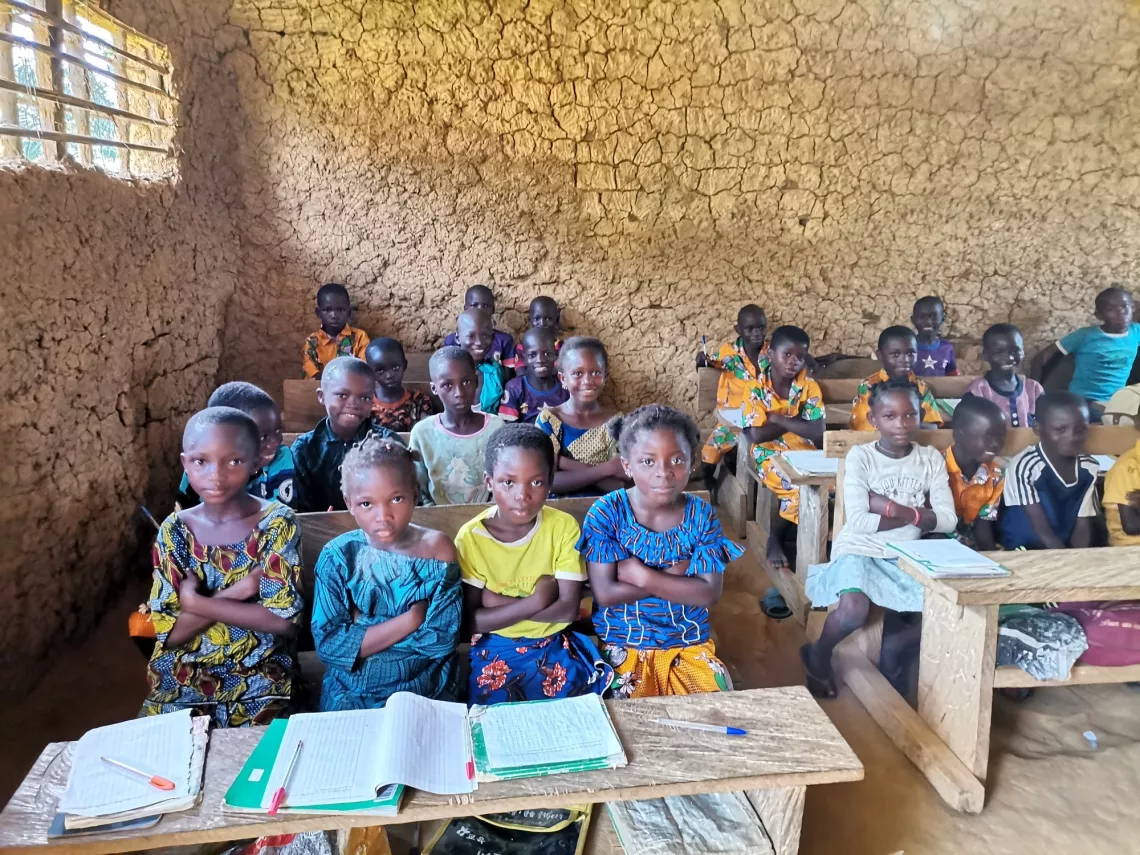School infrastructure and education quality: a positive impact on the learning environment
The Recycled Plastic Brick School Infrastructure Project

- Available in:
- Français
- English
The Binkadi community school was created during the 2007-2008 school year to avoid hundreds of children from this village having to walk more than 4 km every day to reach the existing public elementary school in Nagbatché, a neighbouring village.
It is 2:40 pm when the UNICEF team and the Inspectorate of Primary and Pre-school Education (IEPP) of Grabo finish walking the last kilometre to reach the village of Binkadi, located over 700 km from Abidjan. The trip included 150 km of muddy tracks to cover over a 4 hours’ drive from San-Pédro. This community school brings together children from various religious communities, ethnic groups, and nationalities.

“Here, we have Ivorian communities, such as the Lobi, Baoulé, Tagbanan, and Senoufo ethnic groups, the Burkinabe communities, such as the Dagori and Morés, and the Niagas, a Malian community,” explained Mr. Dembélé Moussa, President of the School Management Committee, when he welcomed the delegation. The main activity of the people living in this remote area of San-Pédro is the cultivation of cocoa and palm seeds. The Binkadi school currently has 103 students, including 32 girls from the six surrounding villages. Petit Korhogo, 4 km away, is the farthest of the surrounding villages. Dioulabougou is 3 km away, whereas Agbokro is 2 km away, and Sougalodougou, N'Guessankro, and Moussadougou are all 1 km away.
Diarra Aminata is part of this group. She is about 12 years old and is in CE2. We don't really know her exact age since her parents have not yet established her birth certificate.
"We don't have latrines in the school. We go in the bushes or in the house when we need to. Three or four of us sit on a bench and it is very difficult to write and follow what the teacher says. We learned that we would have a school like in the city, with books, notebooks, and bags. I dream about it every night and I can't wait.”

The Binkadi community school has four classrooms and a teacher’s house, built with temporary materials, and only one traditional latrine used by both teachers and students. Household wells in the vicinity serve as water points for the students. “In spite of this lack of facilities, twelve out of seventeen CM2 students who sat for the CEPE (First grade certificate} exam last year were admitted and there are also two students from the first class who passed the BAC D: one girl and one boy. I assure you that these results have been echoed. It is a source of pride for me as a teacher and it is also felt in the community. The parents are increasingly involved in the management of the school. We hope to do better, but when the harvest is not good, some parents can't even afford to pay for a single notebook for their children,” said Mr. Laffi N'Kone, the school's director.

“There are six grades that work in tandem. The CP1 and CP2, CE1 and CE2, CM1 and CM2 classes are put together since there are only three volunteer teachers, one of whom is Mr. Laffi, the Director. We have high expectations for this project.”
Despite the school being included on the school map, it does not have any teachers assigned by the Government. It functions thanks to community involvement. “Before the state sent us teachers, we took our responsibilities as parents and created a School Management Committee. We agreed to contribute each year to the management of the school. We take care of the teachers who supervise our children as well as the materials they need for the school and the classes. The women’s group oversees the food,” said Mr. Sawadogo Mamadou, the treasurer. The community has ceded a one-hectare land for the construction of the school.
UNICEF contribution
Improving infrastructure alone is not enough to ensure that every child receives a quality education. UNICEF is developing an integrated approach to ensure that every element is in place for children to stay in school and get a quality education. In addition to the construction of new schools and classrooms, this includes school supplies, desks, blackboards, the installation of toilets and handwashing facilities, the training of teachers, the engagement of parents, the creation of shaded areas within recreation areas, and awareness raising activities on environmental issues.
Through the Recycled Plastic Brick School Infrastructure Project, UNICEF is supporting the Government of Côte d’Ivoire’s plan relative to the implementation of its Education Sector Plan (ESP 2016-2025), which aims to build an average of at least 3,000 classrooms per year until 2025 to achieve universal primary completion.





